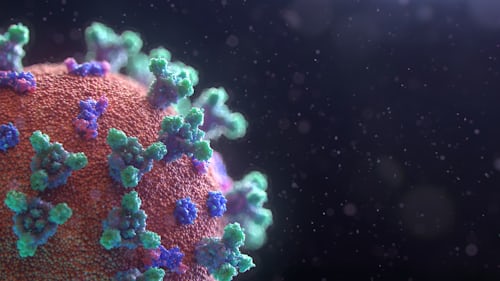Introduction
Coronaviruses are a group of related viruses that cause diseases in mammals and birds. In humans, coronaviruses cause respiratory tract infections that can be mild, such as some cases of the common cold (among other possible causes), and others that can be lethal, such as SARS, MERS, and COVID-19. Symptoms in other species vary: in chickens, they cause an upper respiratory tract disease, while in cows and pigs they cause diarrhea.
Coronaviruses constitute the subfamily Orthocoronavirinae, in the family Coronaviridae. They are enveloped viruses with a positive-sense single-stranded RNA genome and a nucleocapsid of helical symmetry. The genome size of coronaviruses ranges from approximately 27 to 34 kilobases, the largest among known RNA viruses. The name coronavirus is came from the Latin corona, meaning “crown” or “halo”, which refers to the characteristic appearance of a crown or a solar corona around the virions (virus particles) when viewed under two-dimensional transmission electron microscopy, due to the surface covering in club-shaped protein spikes.
First were discovered in the late 1960s.
COVID-19
Coronavirus disease 2019 (COVID-19) is an infectious disease caused by respiratory syndrome coronavirus 2 (SARS-CoV-2). The disease was first identified in 2019 in Wuhan, China, and has since spread globally, resulting in the 2019–20 coronavirus pandemic.Common symptoms include fever, cough and shortness of breath. Muscle pain, sore throat are less common. While the majority of cases result in mild symptoms, some progress to severe pneumonia and multi-organ failure. The rate of deaths per number of diagnosed cases is on average 3.4%, ranging from 0.2% in those less than 20 to approximately 15% in those over 80 years old.
The infection is typically spread from one person to another via respiratory droplets produced during coughing and sneezing. Time from exposure to onset of symptoms is generally between 2 and 14 days, with an average of five days.
The World Health Organization (WHO) declared the 2019–20 coronavirus outbreak a pandemic and a Public Health Emergency of International Concern (PHEIC). Evidence of local transmission of the disease has been found in many countries across all six WHO regions.
Signs and Symptoms
Many developed infected people have flu-like symptoms including fever, cough, and shortness of breath. Less commonly: upper respiratory symptoms such as sneezing, runny nose, or sore throat may be seen. Symptoms such as nausea, vomiting, and diarrhoea are seen in a minority of cases. In some, the disease may progress to pneumonia, multi-organ failure, and death.
As is common with infections, there is a delay from when a person is infected with the virus to when they develop symptoms, know as the incubation period. The incubation period for COVID-19 is typically five to six days but may range from two to 14 days.
Mild cases typically can be recovered within two weeks, while those with severe or critical disease may take three to six weeks to recover. Among those who have died, the time from symptom onset to death has ranged from two to eight weeks.

No comments:
Post a Comment